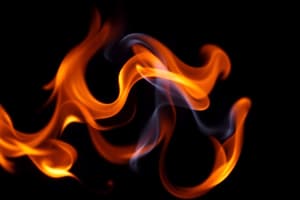Podcast
Questions and Answers
What is the primary characteristic of combustion reactions that makes them useful for providing energy?
What is the primary characteristic of combustion reactions that makes them useful for providing energy?
Exothermicity, meaning they release more energy than is required to initiate the reaction
What is the typical reactant involved in the oxidation of a fuel during combustion?
What is the typical reactant involved in the oxidation of a fuel during combustion?
Oxygen
What is the role of ignition sources in combustion reactions?
What is the role of ignition sources in combustion reactions?
To initiate the reaction
What is the ultimate goal of understanding combustion reactions and their processes?
What is the ultimate goal of understanding combustion reactions and their processes?
What are the three key aspects of combustion reactions?
What are the three key aspects of combustion reactions?
What is the primary role of an ignition source in combustion?
What is the primary role of an ignition source in combustion?
Which type of ignition source generates heat through mechanical energy?
Which type of ignition source generates heat through mechanical energy?
What is the purpose of a spark plug in an internal combustion engine?
What is the purpose of a spark plug in an internal combustion engine?
What type of radiation can be sufficient to ignite a fuel?
What type of radiation can be sufficient to ignite a fuel?
What is the common application of open flames in combustion?
What is the common application of open flames in combustion?
Flashcards are hidden until you start studying
Study Notes
Combustion: Ignition Sources and Combustion Reactions
Combustion is a crucial aspect of chemistry and has significant applications in various fields, including transportation, power generation, and heating. It involves chemical reactions between substances, usually including oxygen and often resulting in the generation of heat and light. The ignition source is a critical factor in initiating combustion, while combustion reactions are the chemical transformations that occur during the combustion process.
Ignition Sources
Ignition sources play a vital role in initiating combustion reactions. Some common ignition sources include:
- Friction: Friction can generate enough heat to ignite a fuel. This is evident when striking a match; the friction between the match head and the striking surface generates heat, which in turn ignites the fuel.
- Sparks: A spark can provide the necessary energy to initiate combustion. This can be seen in the ignition system of an internal combustion engine, where a spark plug creates a spark to ignite the fuel-air mixture.
- High-energy radiation: Certain materials, such as fluorescent lamps, can emit high-energy radiation that can be sufficient to ignite a fuel.
- Open flames: An open flame can ignite a fuel by providing a source of heat. This is commonly used in gas stoves and gas heaters.
Combustion Reactions
Combustion reactions are chemical transformations that occur during the combustion process. They are often highly exothermic, meaning they release a large amount of energy. Combustion systems utilize the energy released during these reactions to provide transportation, generate electric power, or provide heat for various applications. Some key aspects of combustion reactions include:
- Exothermicity: Combustion reactions are typically highly exothermic, meaning they release more energy than is required to initiate the reaction. This excess energy is responsible for the heat and light generated during combustion.
- Oxidation: Combustion often involves the oxidation of a fuel, typically by oxygen. This process is often accompanied by the generation of heat and light in the form of a flame.
- Heat release: The energy released during combustion reactions can be harnessed for various applications, such as power generation or heating.
In summary, combustion is a complex process that involves both chemical reactions and the release of energy. Ignition sources are crucial in initiating these reactions, while combustion reactions themselves are characterized by their exothermicity, oxidation, and heat release. Understanding these processes is essential for the development and optimization of combustion systems for various practical applications.
Studying That Suits You
Use AI to generate personalized quizzes and flashcards to suit your learning preferences.



